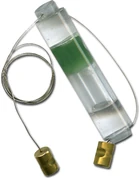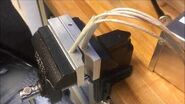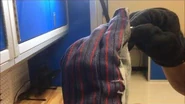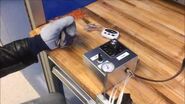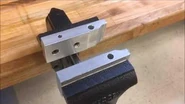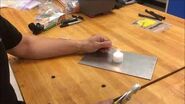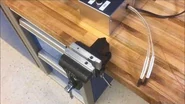Tom Sponheim (talk | contribs) |
Tom Sponheim (talk | contribs) mNo edit summary Tag: Source edit |
||
| (22 intermediate revisions by 4 users not shown) | |||
| Line 1: | Line 1: | ||
{{GoogleTranslateLinks}} |
{{GoogleTranslateLinks}} |
||
| + | {{Updated|11|30|17}} |
||
| − | |||
| − | |||
Below is detailed information about buying and/or making [[Water Pasteurization Indicator]]s (WAPIs). |
Below is detailed information about buying and/or making [[Water Pasteurization Indicator]]s (WAPIs). |
||
| + | ==WAPI Kit for making 200 WAPIs== |
||
| − | ==Purchasing WAPIs from Solar Cookers International== |
||
| + | [[File:Superwapi1_large.jpg|right|139px]] |
||
| − | WAPIs can be [http://shop.solarcookers.org/?pn=WAPI&cn=Water+Pasteurization&p=630&c=31 purchased from Solar Cookers International] (SCI). For information on bulk purchases, contact the office at +1 (916) 455-4499. |
||
| + | The Monterey Peninsula Sunrise Rotary Club has WAPI Kits available. The WAPI Kit is shipped with assembly instructions and the materials needed to build 200 WAPIs. The cost of the kit is $85 plus shipping. That's $.42 per WAPI. Why is the cost so reasonable? The club purchases the supplies in large quanities at substantial discounts which are passed on to you. All components are prepared for use and packaged in the kit. This is a great hands-on project for Rotary clubs, Interact, Rotaract, church groups and other service minded groups. With this kit the WAPI is simple and fun to build. WAPIs save lives every day. For more information and to order the kit contact Past District Governor Don Kremer at [mailto:WAPI@pacbell.net WAPI@pacbell.net]. |
||
| − | |||
| − | [[File:Superwapi1_large.jpg|thumb|none|209px|The WAPI model sold by [http://shop.solarcookers.org/?pn=WAPI&cn=Water+Pasteurization&p=630&c=31 Solar Cookers International]]] |
||
| − | ==Making your own== |
+ | ==Making your own WAPIs== |
#If you make them yourself you run into quality control issues. Here is how [[Bob Metcalf]] handles quality control on the ones he makes. After he makes them, he puts them into hot water so that the wax melts and runs into the bottom of the tube. Then he inspects them visually for any holes in the tube and for the other indicator of a problem: water inside the tube. Then he repeats the process a second time. You can melt the wax of a batch of WAPIs at one time, rather than heating one individually. When heating them in water, watch for wax coming to the surface of the hot water. That will be a sign that one or more of the WAPIs in that batch definitely are leaking. Whether or not you see wax on the surface of the water, each and every WAPI should be visually inspected after both of the hot water tests. Any WAPI that shows any sign of leakage is thrown away in a place where it will be sure not to get mixed up with the good WAPIs. Bob says he throws away 1 out of every 10 or 15 WAPIs he makes, so you can see that there is a cost factor to consider. |
#If you make them yourself you run into quality control issues. Here is how [[Bob Metcalf]] handles quality control on the ones he makes. After he makes them, he puts them into hot water so that the wax melts and runs into the bottom of the tube. Then he inspects them visually for any holes in the tube and for the other indicator of a problem: water inside the tube. Then he repeats the process a second time. You can melt the wax of a batch of WAPIs at one time, rather than heating one individually. When heating them in water, watch for wax coming to the surface of the hot water. That will be a sign that one or more of the WAPIs in that batch definitely are leaking. Whether or not you see wax on the surface of the water, each and every WAPI should be visually inspected after both of the hot water tests. Any WAPI that shows any sign of leakage is thrown away in a place where it will be sure not to get mixed up with the good WAPIs. Bob says he throws away 1 out of every 10 or 15 WAPIs he makes, so you can see that there is a cost factor to consider. |
||
#Making one or two WAPIs is a major pain. The tubing comes in 8-foot lengths, which makes it a little hard to handle. Bob uses a band saw available at his university to cut them, but he describes the cutting process as a "bother." |
#Making one or two WAPIs is a major pain. The tubing comes in 8-foot lengths, which makes it a little hard to handle. Bob uses a band saw available at his university to cut them, but he describes the cutting process as a "bother." |
||
| Line 14: | Line 12: | ||
[[Image:Rotary_Youth_Leadership_Awards_youth_Southern_CA_2009.jpg|thumb|300px|Rotary Youth Leadership Awards youth making [[WAPI]]s in Southern California for use in projects around the world.]] |
[[Image:Rotary_Youth_Leadership_Awards_youth_Southern_CA_2009.jpg|thumb|300px|Rotary Youth Leadership Awards youth making [[WAPI]]s in Southern California for use in projects around the world.]] |
||
| − | [[Bob Metcalf]] |
+ | [[Bob Metcalf]] may be willing to give you a small supply of the wax, which he estimates will be more than enough for 500 WAPIs and perhaps enough for 1000. |
The wax for use inside the WAPI is available here: |
The wax for use inside the WAPI is available here: |
||
| Line 26: | Line 24: | ||
F: +1 (847) 645-7064 |
F: +1 (847) 645-7064 |
||
| − | The type of wax we use is called Myverol, and the specific product is known as Myverol 18-06, which has a melting point of 69° C. Apparently, the smallest unit that they sell this product in is a box about 1 foot square, which weighs about 45 pounds (20 kg). |
+ | The type of wax we use is called Myverol, and the specific product is known as Myverol 18-06, which has a melting point of 69° C. Apparently, the smallest unit that they sell this product in is a box about 1 foot square, which weighs about 45 pounds (20 kg). This would be enough for untold thousands of WAPIs. |
| − | The tubing |
+ | The tubing used is .373 inches outside diameter, and the wall thickness is about .060 inches. It is important to be sure that you use a polycarbonate tubing, which Lexan is, but double check with your dealer, because other plastics (ones that are not polycarbonate) lack either the temperature stability or the optical clarity that is needed. |
The Lexan tubing can be obtained from McMaster-Carr in Los Angeles. This is the contact info: |
The Lexan tubing can be obtained from McMaster-Carr in Los Angeles. This is the contact info: |
||
| Line 40: | Line 38: | ||
F: 562-695-2323 |
F: 562-695-2323 |
||
| − | http://www.mcmaster.com |
+ | http://www.mcmaster.com/#catalog/119/3555/=p8gvgk |
The product number is 8585K11. It comes only in 8 ft. lengths. at 60 cents a foot. |
The product number is 8585K11. It comes only in 8 ft. lengths. at 60 cents a foot. |
||
| − | The measurements |
+ | The measurements given above were more exact than what the company's website gives--it says 3/8 inch exterior diameter and 1/4 inch interior diameter, which is fairly close to the figures given above. |
| − | + | Quality control is important! Check every WAPI twice and look to see if ANY water has gotten inside the WAPI, because water will affect the wax, which will then possibly melt at temperatures below pasteurization temperature. |
|
| − | + | When you make the WAPI's you put enough wax in the tube to fill it about half way. (The wax comes dry and powdered, looking a lot like fine grated Parmesan cheese.) After the first time it melts, it will be a solid chunk at the bottom of the tube. |
|
[[Bob Nepper]] also has worked with Rotary Clubs to build large numbers of WAPIs for use in international projects. |
[[Bob Nepper]] also has worked with Rotary Clubs to build large numbers of WAPIs for use in international projects. |
||
==WAPIs with stainless steel wire== |
==WAPIs with stainless steel wire== |
||
| − | The [ |
+ | The [http://www.montereysunriserotary.org/wapi.html Monterey Sunrise Rotory Club] now has WAPI kits available in which stainless steel wire replaces the monofiliment fishing line and is good for all applications including Open flame fires, which had the tendency to melt the traditional fishing line. The Kit contans all the components and instructions to build 200 WAPIs. These are reusable and virtually indestructable. The cost is $85 (about $.42 each) plus shipping. If you are interested in a fun project that teaches about the perils of unclean water and then show folks how to make a difference, contact us at [mailto:WAPI@pacbell.net WAPI@pacbell.net]. This is a great fellowship project for [[:Category:Rotary Clubs|Rotary Clubs]], Rotary Interact Clubs, Church youth groups, etc. |
| + | |||
==Cool WAPI== |
==Cool WAPI== |
||
[[File:Cool_WAPI_kit,_1-29-13.jpg|thumb|300px|The Cool WAPI can be purchased assembled or as this kit. See various types, and purchasing information at the [[Media:Cool_Wapi_- _Bob_Nepper_January_2013.pdf|Cool WAPI]]]] |
[[File:Cool_WAPI_kit,_1-29-13.jpg|thumb|300px|The Cool WAPI can be purchased assembled or as this kit. See various types, and purchasing information at the [[Media:Cool_Wapi_- _Bob_Nepper_January_2013.pdf|Cool WAPI]]]] |
||
| Line 58: | Line 57: | ||
See [[Media:Cool_WAPI_Assembly_Instructions_3-04-09.pdf|Instructions for Assembling the Cool WAPI]]. |
See [[Media:Cool_WAPI_Assembly_Instructions_3-04-09.pdf|Instructions for Assembling the Cool WAPI]]. |
||
| + | |||
| + | [[File:Cool_WAPI,_North_Star_Devices,_Inc.,_12-11-13.jpg|thumb|250px|The Cool WAPI from North Star Devices, Inc.]] |
||
| + | *'''December 2013:''' [[Robert Nepper]] reports that they have made improvements to the SuperWAPI, which features a heat resistant stainless steel cable. North Star Devices' WAPI is the only WAPI offered as a hammer together design, not requiring heat sealing. The SuperWAPI is also now available as a kit. Read more about their WAPIs in their latest flyer: [[Media:WaPIFlyer3.pdf|Reusable Water Pasteurization Indicators (WAPIs)]] |
||
| + | {{Clr}} |
||
| + | =={{HeadingVideo}}== |
||
| + | *{{NewDec17}}'''December 2017:''' Below is a series of short videos explaining [[WAPI]] production, made by Akihiko Kumagai and Marshall Ndlovu from [http://www.csus.edu California State University], Sacramento, {{State|California}}, [[USA]]. |
||
| + | :<gallery> |
||
| + | VIdeo 1 How to set up the WAPI maker |
||
| + | VIdeo 2 Making WAPIs |
||
| + | VIdeo 3 How to turn OFF the WAPI maker |
||
| + | VIdeo 4 Trouble shoorings |
||
| + | VIdeo 5 Making WAPIs with candle flame |
||
| + | VIdeo 6 Candle or the WAPI maker |
||
| + | </gallery> |
||
==Reports== |
==Reports== |
||
| + | *{{NewMar17}}'''January 2017:''' [[Media:What_would_be_a_Sustainable_Water_Pasteurization_Indicator_(WAPI)_Producing_Method_for_Developing_Countries_Kumagai.pdf|What Would be a Sustainable Water Pasteurization Indicator (WAPI) Producing Method for Developing Countries?]] [http://solarcooking.org/conferences/WAPI_Production_Method_for_Developing_Countries_Kumagai_slides.pdf (slides)] - ''Akihiko Kumagai'' |
||
| + | |||
*'''November 2009:''' [[Media:SCN-Kozon-How_to_make_Cookit_WAPI_20-11-2009.pdf|Manual: How to make a CooKit and a WAPI]] - [[Solar Cooking Netherlands]] and the [[KoZon Foundation]]. |
*'''November 2009:''' [[Media:SCN-Kozon-How_to_make_Cookit_WAPI_20-11-2009.pdf|Manual: How to make a CooKit and a WAPI]] - [[Solar Cooking Netherlands]] and the [[KoZon Foundation]]. |
||
| Line 69: | Line 84: | ||
*[[Water pasteurization]] |
*[[Water pasteurization]] |
||
*[[Water Pasteurization Indicator]] |
*[[Water Pasteurization Indicator]] |
||
| − | |||
| − | ==External links== |
||
| − | * [http://shop.solarcookers.org/?pn=WAPI&cn=Water+Pasteurization&p=630&c=31 Purchase WAPIs from Solar Cookers International] |
||
| − | [[Category:Materials]] |
||
Latest revision as of 18:24, 30 June 2023
|
Last edited: 30 November 2017
|
Below is detailed information about buying and/or making Water Pasteurization Indicators (WAPIs).
WAPI Kit for making 200 WAPIs[]
The Monterey Peninsula Sunrise Rotary Club has WAPI Kits available. The WAPI Kit is shipped with assembly instructions and the materials needed to build 200 WAPIs. The cost of the kit is $85 plus shipping. That's $.42 per WAPI. Why is the cost so reasonable? The club purchases the supplies in large quanities at substantial discounts which are passed on to you. All components are prepared for use and packaged in the kit. This is a great hands-on project for Rotary clubs, Interact, Rotaract, church groups and other service minded groups. With this kit the WAPI is simple and fun to build. WAPIs save lives every day. For more information and to order the kit contact Past District Governor Don Kremer at WAPI@pacbell.net.
Making your own WAPIs[]
- If you make them yourself you run into quality control issues. Here is how Bob Metcalf handles quality control on the ones he makes. After he makes them, he puts them into hot water so that the wax melts and runs into the bottom of the tube. Then he inspects them visually for any holes in the tube and for the other indicator of a problem: water inside the tube. Then he repeats the process a second time. You can melt the wax of a batch of WAPIs at one time, rather than heating one individually. When heating them in water, watch for wax coming to the surface of the hot water. That will be a sign that one or more of the WAPIs in that batch definitely are leaking. Whether or not you see wax on the surface of the water, each and every WAPI should be visually inspected after both of the hot water tests. Any WAPI that shows any sign of leakage is thrown away in a place where it will be sure not to get mixed up with the good WAPIs. Bob says he throws away 1 out of every 10 or 15 WAPIs he makes, so you can see that there is a cost factor to consider.
- Making one or two WAPIs is a major pain. The tubing comes in 8-foot lengths, which makes it a little hard to handle. Bob uses a band saw available at his university to cut them, but he describes the cutting process as a "bother."
- In addition to purchasing the wax and the tubing, you'll also have to purchase the fish line and the washers.
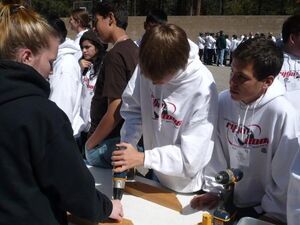
Rotary Youth Leadership Awards youth making WAPIs in Southern California for use in projects around the world.
Bob Metcalf may be willing to give you a small supply of the wax, which he estimates will be more than enough for 500 WAPIs and perhaps enough for 1000.
The wax for use inside the WAPI is available here:
Quest International
5115 Sedge Blvd.
Hoffman Estates, IL 60192
USA
Tel: +1 (847) 645-7000
F: +1 (847) 645-7064
The type of wax we use is called Myverol, and the specific product is known as Myverol 18-06, which has a melting point of 69° C. Apparently, the smallest unit that they sell this product in is a box about 1 foot square, which weighs about 45 pounds (20 kg). This would be enough for untold thousands of WAPIs.
The tubing used is .373 inches outside diameter, and the wall thickness is about .060 inches. It is important to be sure that you use a polycarbonate tubing, which Lexan is, but double check with your dealer, because other plastics (ones that are not polycarbonate) lack either the temperature stability or the optical clarity that is needed.
The Lexan tubing can be obtained from McMaster-Carr in Los Angeles. This is the contact info:
McMaster-Carr Supply Co.
P.O. Box 54960
Los Angeles, CA 90054-0960
USA
Phone: 562-692-5911
F: 562-695-2323
http://www.mcmaster.com/#catalog/119/3555/=p8gvgk
The product number is 8585K11. It comes only in 8 ft. lengths. at 60 cents a foot. The measurements given above were more exact than what the company's website gives--it says 3/8 inch exterior diameter and 1/4 inch interior diameter, which is fairly close to the figures given above.
Quality control is important! Check every WAPI twice and look to see if ANY water has gotten inside the WAPI, because water will affect the wax, which will then possibly melt at temperatures below pasteurization temperature.
When you make the WAPI's you put enough wax in the tube to fill it about half way. (The wax comes dry and powdered, looking a lot like fine grated Parmesan cheese.) After the first time it melts, it will be a solid chunk at the bottom of the tube.
Bob Nepper also has worked with Rotary Clubs to build large numbers of WAPIs for use in international projects.
WAPIs with stainless steel wire[]
The Monterey Sunrise Rotory Club now has WAPI kits available in which stainless steel wire replaces the monofiliment fishing line and is good for all applications including Open flame fires, which had the tendency to melt the traditional fishing line. The Kit contans all the components and instructions to build 200 WAPIs. These are reusable and virtually indestructable. The cost is $85 (about $.42 each) plus shipping. If you are interested in a fun project that teaches about the perils of unclean water and then show folks how to make a difference, contact us at WAPI@pacbell.net. This is a great fellowship project for Rotary Clubs, Rotary Interact Clubs, Church youth groups, etc.
Cool WAPI[]
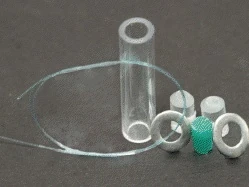
The Cool WAPI can be purchased assembled or as this kit. See various types, and purchasing information at the Cool WAPI
A Cool WAPI design does not require heat sealing the tube, but uses a plug to seal the ends instead. See various types, and purchasing information at the Cool WAPI
See Instructions for Assembling the Cool WAPI.
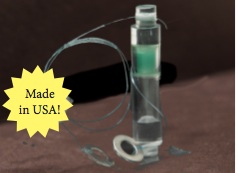
The Cool WAPI from North Star Devices, Inc.
- December 2013: Robert Nepper reports that they have made improvements to the SuperWAPI, which features a heat resistant stainless steel cable. North Star Devices' WAPI is the only WAPI offered as a hammer together design, not requiring heat sealing. The SuperWAPI is also now available as a kit. Read more about their WAPIs in their latest flyer: Reusable Water Pasteurization Indicators (WAPIs)
Audio and video[]
- December 2017: Below is a series of short videos explaining WAPI production, made by Akihiko Kumagai and Marshall Ndlovu from California State University, Sacramento, California, USA.
Reports[]
- January 2017: What Would be a Sustainable Water Pasteurization Indicator (WAPI) Producing Method for Developing Countries? (slides) - Akihiko Kumagai
- November 2009: Manual: How to make a CooKit and a WAPI - Solar Cooking Netherlands and the KoZon Foundation.
- October 2009: Flyer: How to use the Integrated Sustainable Solar Cooking method and a WAPI - Solar Cooking Netherlands and the KoZon Foundation.
- October 2009: Manual: How to use the Integrated Sustainable Solar Cooking method and a WAPI - Solar Cooking Netherlands and the KoZon Foundation.

